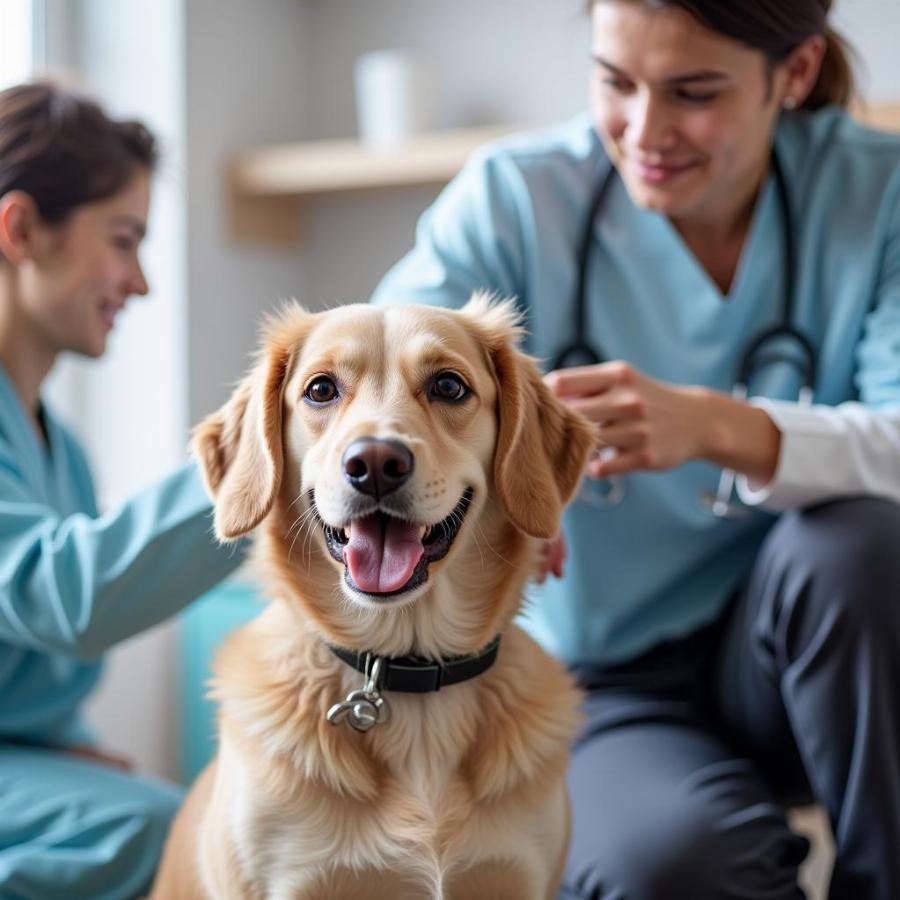Lymphadenopathy in dogs, simply put, refers to enlarged lymph nodes. While not a disease in itself, it’s a crucial indicator that something might be amiss with your furry friend’s health. Lymph nodes play a vital role in the immune system, acting as filters that trap bacteria, viruses, and other harmful substances. Swelling indicates they’re working overtime, often in response to an infection or other underlying issue. Recognizing and understanding lymphadenopathy is essential for any dog owner concerned about their pet’s well-being.
What are Lymph Nodes and Why Do They Swell?
Lymph nodes are small, bean-shaped structures located throughout a dog’s body, connected by a network of lymphatic vessels. Think of them as tiny security checkpoints, constantly monitoring for threats. When they detect something harmful, they swell as immune cells multiply to fight the invader. This swelling is what we refer to as lymphadenopathy. Several factors can cause this reaction, from relatively minor infections to more serious conditions.
Common Causes of Lymphadenopathy in Dogs
- Infections: Bacterial, viral, fungal, and parasitic infections are frequent culprits. A simple skin infection or a more complex systemic illness can trigger lymph node enlargement.
- Inflammation: Injuries, allergies, or autoimmune diseases can cause inflammation, leading to swollen lymph nodes in the affected area.
- Cancer: Unfortunately, certain types of cancer, such as lymphoma, can directly affect the lymph nodes, causing them to enlarge. Lymphadenopathy can also be a sign that cancer has spread from another part of the body.
Recognizing Swollen Lymph Nodes in Your Dog
While some lymph nodes are always palpable (meaning you can feel them), significant enlargement is often a cause for concern. The most easily accessible lymph nodes are located under the jaw (submandibular), in front of the shoulders (prescapular), in the armpits (axillary), and behind the knees (popliteal). Gently feeling these areas can help you detect any unusual swelling.
What to Look For:
- Size: Compare the size of the lymph nodes on both sides of the body. A noticeable difference could indicate a problem.
- Texture: Healthy lymph nodes feel firm and somewhat movable. Hard, fixed, or painful nodes should be checked by a veterinarian.
- Other Symptoms: Lymphadenopathy is rarely an isolated symptom. Look for other signs of illness, such as lethargy, loss of appetite, fever, or skin changes.
When to See a Veterinarian
If you detect swollen lymph nodes in your dog, it’s always best to consult with your veterinarian. They can determine the underlying cause and recommend the appropriate course of action.
Diagnostic Process
Your veterinarian will likely perform a physical exam and ask about your dog’s history. Further diagnostic tests, such as blood work, biopsies, or imaging (X-rays, ultrasound), may be necessary to pinpoint the diagnosis.
“Early detection is key, especially when dealing with potentially serious conditions,” says Dr. Emily Carter, DVM, a board-certified veterinary oncologist. “Don’t hesitate to bring your dog in for a check-up if you notice any unusual swelling.”
Treatment and Prognosis
The treatment for lymphadenopathy depends entirely on the underlying cause. For example, a bacterial infection may require antibiotics, while cancer may necessitate chemotherapy or surgery. The prognosis varies depending on the severity and nature of the underlying condition.
Home Care and Monitoring
While professional veterinary care is essential, you can also provide supportive care at home. Ensure your dog has a comfortable resting place, plenty of fresh water, and a nutritious diet. Monitor their lymph nodes regularly and report any changes to your veterinarian.
 Dog Receiving Veterinary Care
Dog Receiving Veterinary Care
Conclusion
Lymphadenopathy in dogs is a significant sign that shouldn’t be ignored. While it can be caused by relatively minor issues, it can also indicate more serious underlying conditions. By being aware of the causes, symptoms, and importance of seeking veterinary care, you can play a vital role in ensuring your furry companion’s health and well-being. Regularly checking your dog’s lymph nodes, along with observing for other signs of illness, is a simple yet crucial part of responsible pet ownership. Remember, early detection and prompt treatment are often key to a positive outcome.
FAQ:
- Can stress cause swollen lymph nodes in dogs? While stress can impact the immune system, it’s not a direct cause of lymphadenopathy.
- Are all swollen lymph nodes cancerous? No, most cases of lymphadenopathy are caused by infections or inflammation.
- How long does it take for swollen lymph nodes to return to normal size? The recovery time varies depending on the underlying cause. It could take a few days for a minor infection or several weeks for a more serious condition.
- What should I do if my dog’s lymph nodes are suddenly very large and painful? Seek immediate veterinary attention.
- Can vaccinations cause lymphadenopathy? Mild, temporary swelling near the injection site is sometimes normal after vaccination.
- Is lymphadenopathy contagious? The condition itself is not contagious, but the underlying cause (like an infection) might be.
- Can certain breeds be more prone to lymphadenopathy? Some breeds are predisposed to certain cancers that can affect the lymph nodes.
Further Reading:
- Understanding Canine Cancer
- Boosting Your Dog’s Immune System
- Common Canine Infections
Beaut Dogs is your go-to resource for all things related to dog care. We offer expert advice and comprehensive information to help you navigate the joys and challenges of dog ownership. For personalized guidance and answers to your specific questions, please contact us at [email protected]. Beaut Dogs is committed to providing accurate and reliable information to help you provide the best care for your beloved canine companion. Visit us at https://beautdogs.com.